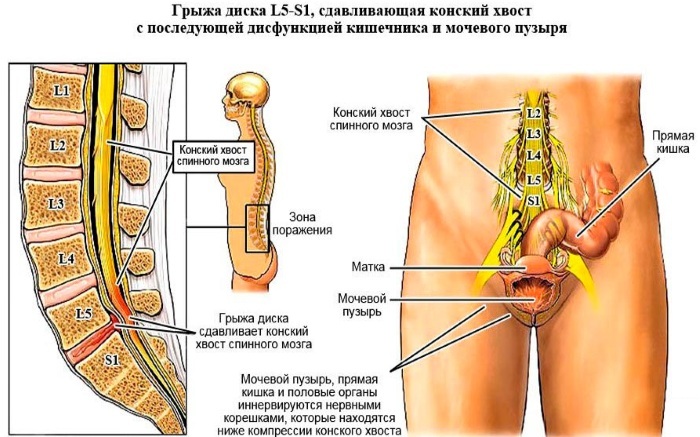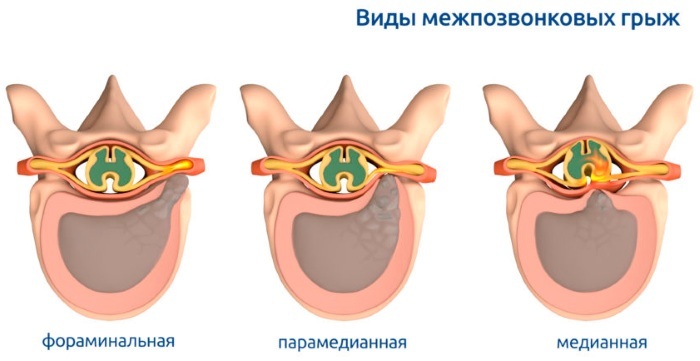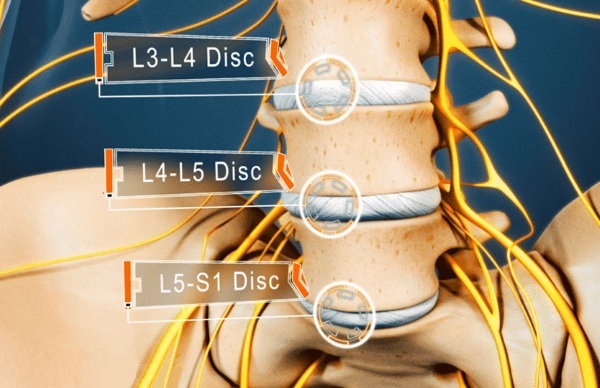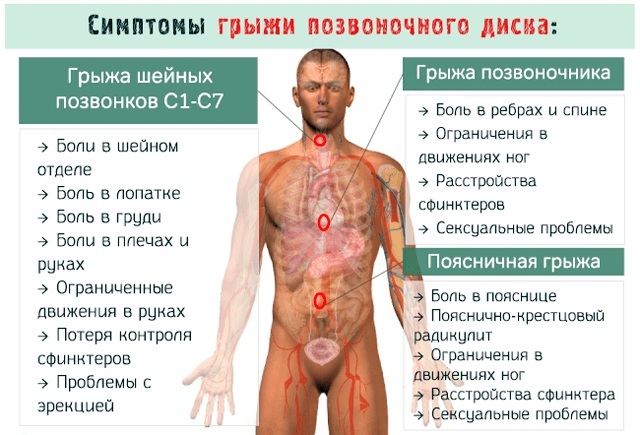Content
- Segment L5-S1
- Why does L5-S1 disc herniation appear?
- Types of protrusions L5-S1
- What are the herniated discs?
- Symptoms and pains of L5-S1 disc herniation
- Do medications help?
- The effect of gymnastic exercises
- Does massage help?
- Complications and consequences of intervertebral hernia
- Video about L5-S1 hernia
The confluence of various negative circumstances, as well as the age of the patient, contributes to wear of intervertebral discs. In most cases, such degenerative processes are located in the L5-S1 region. This leads to the occurrence of hernias, which have a negative impact on the quality of life, provoking paresthesias, paralysis, as well as severe pain and erectile dysfunction.
Segment L5-S1
L5-S1 hernia is located in the region of the last vertebra and the lumbar sacrum. The defeat of such an area is the most frequent pathological process due to the fact that its location is in the lumbar region.
The degenerative changes arising in this segment are inherent in scoliosis, metabolic disorders, as well as osteochondrosis and obesity. In addition, a significant proportion of cases are incorrect performance of power loads, as well as a lack of motor function and a sedentary, sedentary lifestyle.

The L5-S1 segment is located in the area of intersection of a large plexus of nerve endings, which in medical practice are called the cauda equina. Due to this, the formation of a hernia contributes to the rapid development of strong painful sensations, which often leads to dangerous complications of a neurological nature.
The so-called cauda equina syndrome provokes the development of paresthesia in the perineum and posterior parts of the thigh, increases the general weakness of the muscle tissue in the legs, and also leads to urinary incontinence and feces. In men, this disease often leads to erectile dysfunction.
Why does L5-S1 disc herniation appear?
At the moment, the main factor that contributes to the formation of a hernia is considered to be degenerative changes in the bone structure of the disc. At the same time, the exact reasons for such a pathological process are not fully understood.
In medical practice, it is customary to distinguish 3 main groups of factors that can provoke disorders in the bone tissues of the disc, which leads to the formation of a hernia:
- Genetic. In this case, neoplasms may appear when the patient suffers from certain pathological processes from birth. This also includes a genetically determined reason in which bone density is significantly reduced.
- Disorders of diet and metabolism. If the patient does not take a sufficient amount of beneficial trace elements, vitamins, as well as other important substances, destruction or decrease in bone density occurs. As a result, hernias often appear.
-
Mechanical. This reason is characterized by microtrauma to the bone and muscle elements of the intervertebral disc, which, in the absence of timely treatment, can completely collapse. The patient is most often injured due to heavy overload or scoliosis. Physical activities such as torsion exercises, lifting heavy weights, and constant driving are more likely to increase the overall risk of hernia formation.

Since in an adult, the structure of the intervertebral disc feeds on useful trace elements, vitamins and minerals through movement, - for example when running or walking, having a sedentary and constantly sedentary lifestyle greatly increases the chances of developing a hernia L5-S1.
Despite the fact that many reasons for the development of a hernia are described in medical practice, a protrusion of the disc in some cases may not differ in a pathological course. One such example is the fact that a person in the morning has a slightly higher growth than in the evening, which is due to the physiological reasons for the structure of the body.
L5-S1 hernia (located in the intervertebral disc) can develop due to pathological dysfunctions of the abdominal and pelvic region, which is characterized by the occurrence of severe muscle spasms, as well as an unevenly distributed load on spine.
Due to the incorrect distribution of the load on the spinal region, the patient suffers from general weakness and lethargy. The launched pathological process leads to a significant stretching of the muscle fibers, which reduces the shock-absorbing function of the discs and leads to their protrusion.
Types of protrusions L5-S1
In medical practice, there are some types of protrusions of the L5-S1 type, which are conventionally divided based on the localization zones, the degree of the painful process, as well as the area of the affected tissues:
Commonly diagnosed types L5-S1, based on location and complications:
- Median. In this case, the nucleus pulposus moves closer to the central part of the spinal canal.
- Dorsal. By the nature of the formation, this variety is similar to the median type, however, in this case, the localization of the protrusion is most often displaced, therefore it is not in the center of the disc.
- Paramedian. It is characterized by a protrusion of the hernia, which to a greater extent has a negative effect on the nerve endings of the spinal cord.
- Circular. In this case, the disc often goes beyond its natural boundaries, settling along the entire perimeter of the bone tissue. A rather painful variety due to the strongest displacement.
-
Foraminal. It is one of the most difficult hernias due to the fact that the protrusion is directed directly into the canal of the intervertebral region, thereby blocking the opening in which the nerve endings.

In addition to the above classification, there are also ventral, uniform, foraminal-physiological and lateral protrusions. Such species are much less common.
What are the herniated discs?
In addition to local varieties of L5-S1 hernias, there are other types in medical practice that are characteristic of other parts of the disc. Their classification takes into account the finding of zones of innervation that are distinct from one or another zone of the lumbar segment.
The main types of disc herniation:
- L1-l This type is quite rare due to the complex innervation of the hernia. It affects the body to a lesser extent than the rest of the protrusions, as indicated by the occurrence of minor pain sensations.
- L3-L This type has a greater negative effect on the L4 nerve, which is located in the spinal region. The main symptoms of this type of protrusion are: severe pain, decreased sensitivity, numbness. Similar signs are often given to the front of the thigh.
- L4-L Localized in the spinal nerve ending L5. Of the main signs, there is often an increased weakness in the muscle tissues, which often provokes the raising of the foot and big toe. In addition, the patient suffers from severe pain, there is a decrease in sensitivity and numbness. Such signs often appear in the lumbar and gluteal regions.
-
L5-S It is detected in the area of the spinal nerve ending S1. The main symptomatic manifestations of this type are: increased weakness, numbness and pronounced pain. It is rather difficult for the patient to stand on his toes. Painful sensations come to light in the area of the thigh and lower leg.

In order to understand if the painful sensations of the hernia are caused, or they are symptomatic a sign of another disease, it is necessary to undergo a comprehensive examination, which will determine the cause of the pain. After that, the doctor will be able to diagnose the disease by indicating a specific area of shear or hernia, based on the above classification.
Symptoms and pains of L5-S1 disc herniation
L5-S1 hernia (located in the intervertebral disc) is often capable of proceeding without any symptomatic manifestations, especially in the case when there is no compression of the radicular nerves.
Depending on the characteristics of the body, the structure of bone and muscle tissues, the symptoms of the disease are quite different. The most common and characteristic signs that are well felt by the patient include: painful manifestations, numbness, burning, and also a slight tingling sensation. Such symptoms are explained by pinched nerve endings.
Depending on the pinched nerve, discomfort can be transmitted to different parts of the body. Most often, this is the groin, legs, or buttocks. Such manifestations are able to better determine the nature and type of the pathological process.
Do medications help?
Despite the prevailing opinion, drugs have a positive effect on protrusion, being the main therapeutic effect.
The most popular and effective types of drugs:
| Type of drugs | Features, positive impact |
| Pain relievers | Allows you to cope with painful sensations and discomfort, which are inherent in most cases. Also, the use of this type of drugs makes it possible to cure the damaged area much faster due to the positive effects of some of the constituent elements of the drug. |
| Anti-inflammatory | They help to stop the further development of the pathological process on nearby tissues, and also make it possible to improve the general well-being of the patient. In the absence of this type of medication, the disease can lead to dangerous degenerative changes in the bone tissue. |
| Mineral and vitamin complexes | Promote effective strengthening of bone and muscle tissue. Most often, drugs are used, which include groups of B vitamins, as well as useful microminerals: zinc, calcium and iron. |
| Muscle relaxants | Used to relieve spasms and pain in the affected area. Show high efficiency for pain relief. |
| Diuretic | This type of drug is prescribed to reduce pronounced swelling in muscle or tissue structures. |
| Hondoprotectors | They are able to prevent or slow down the destructive processes in the affected area, as well as quickly restore damaged bone elements. |
In addition to the above drugs, in order to more effectively relieve pain, an injection of anesthetics, including lidocaine and novoacaine, may be prescribed. Injections are given in the affected area. They are also able to increase the effect of pain medications.
Surgical methods of treatment are indicated only when there are stable dysfunctions nerve endings, as well as with the ineffectiveness of other therapeutic procedures or in the absence stability.
Medicines should be used in conjunction with physiotherapy: massage treatments, acupuncture, shock wave and laser therapy. In this case, the patient returns to normal life much faster.
The effect of gymnastic exercises
Physiotherapy is one of the main methods of treating the pathological process, which allows you to strengthen the muscular corset of the back, as well as reduce unnecessary stress on the affected vertebrae. In addition, gymnastic exercises make it possible to improve blood flow and normalize the metabolic process.
Some examples of exercises used:
- Stretch your arms up while lying on your stomach. After that, simultaneously raise the limbs without bending them at the elbow joint and not bending the back. In this position, it is necessary to stay for 30-40 seconds. Perform 4-6 repetitions every day.
- From a supine position, raise straight legs up, slightly lifting them off the floor. The palms are at the bottom of the press, placed under the buttocks. Repeat the cycle of actions, each time staying at the top point for 35 seconds. Here it is important to feel the relaxation of the lumbar spine, which will reduce painful sensations and further stress.
- In the "on all fours" position, it is necessary to alternately raise the left leg and the right arm, then change them and carry out the same cycle in a mirror order. Straightened limbs should be held at the top point for 5-10 seconds.
In addition to the exercises described above, experts recommend doing regular stretching, which allows not only to increase the elasticity of the muscle and bone structure, but also to reduce pain.
It should be remembered that any gymnastic exercises are prescribed exclusively by the attending physician. Physical activities are prohibited in the presence of severe inflammatory processes, diseases of the cardiovascular system, as well as internal bleeding.
The attending physician necessarily pays attention to the patient's age, stage of the disease, as well as the location and type of hernia. Otherwise, exercises may be contraindicated due to the fact that their implementation will only harm the patient's health.
Also, many experts advise performing therapeutic exercises after using a hot shower, which will allow to warm up not only the affected area, but the whole body. In addition, before training, it is imperative to warm up.
Does massage help?
Therapeutic massage is one of the most effective techniques to restore blood circulation in the affected area, as well as stretch and relax muscle tissue.
Massage procedures after surgery show high efficiency, which allows eliminate painful sensations, reduce sensitivity in nerve fibers, and also eliminate atrophy muscle tissue. In addition, the patient's flexibility increases, the level of endorphins rises, which improves overall well-being.
You should pay special attention to the fact that massage cannot be performed with pronounced pain. Before proceeding with any type of exposure, it is necessary to consult a doctor or an experienced specialist.
Other features of the massage procedure to consider:
- Avoid strong pressure, because the impact should be relatively light and gentle. In addition, sharp rubbing or kneading of the muscle structure should be avoided.
- Use oily soothing agents, which will not only allow you to better relax the damaged area, but also create a positive atmosphere during the massage.
- Do not massage the affected area where the protrusion is located. So, you can apply the massage procedure only in the surrounding areas.
- In addition to the painful area, massage the limbs. If the patient complains of severe and shooting pains, any exposure should be discontinued.
Correctly composed and carried out massage complex allows you to stop the further development of the disease in 85% of cases. Together with drug therapy, massage makes it possible to return the natural strength and elasticity to the disc, which largely relieves any painful sensations and discomfort.
It is worth paying special attention to the fact that single sessions will not be able to give the desired effect. The massage is carried out exclusively as directed by the attending physician, preferably every day.
Complications and consequences of intervertebral hernia
L5-S1 hernia (located in the region of the last vertebra and lumbar sacrum) often leads to the most a dangerous consequence - the rapid rupture of nerve and muscle tissues in the area of the annulus fibrosus. In the presence of this pathological process, protrusion is treated much more difficult, while the overall prognosis is significantly deteriorating.
Other complications of LS-S1 protrusion:
- Constant aching pain in the chest, limbs or shoulder joints. Painful sensations are often transferred to nearby organs, therefore they are often confused with diseases of the heart, liver, intestines.
- Significant decrease in the motor function of the spine. In this case, the patient feels unusual movements, which seem to constrict him and prevent him from completely liberating himself. Such a sign often indicates the presence of dangerous complications, including inflammatory or infectious diseases in the bone tissues of the spine.
- Various disorders of the neurological spectrum. This includes persistent headache, high or low blood pressure, and various sleep problems. In addition, the patient often suffers from dizziness, numbness of the limbs and weakness throughout the body.
- Disorders of the genitourinary system and intestines. Such pathological processes most often occur due to the fact that a bulging disc or a separate hernia overpresses the pelvic organs, which leads to a decrease in their functionality.
At the same time, the most terrible complication, which is characteristic of a rapidly developing hernia, is the compression of the human spinal cord, which is fraught with partial or complete paralysis. In the case when such a process is launched, it is almost impossible to recover from it.
Recent studies indicate a relationship between increased fatigue and apathy of the patient in the presence of hernias in the intervertebral region and the waste of a large amount of internal energy due to the compensating properties of the body. According to scientists, this factor may be the cause of the development of many types of depression and obsessive-compulsive disorder.
Even in the case when an effective treatment of an intervertebral hernia, which is located in the L5-S1 segment, has been carried out, it is necessary to adhere to important preventive norms and recommendations. So, you should avoid strenuous physical activity, eat only those foods that contain large amounts of important minerals and vitamins, and avoid a sedentary lifestyle.
Video about L5-S1 hernia
L5-S1 intervertebral hernia, prosthesis:
